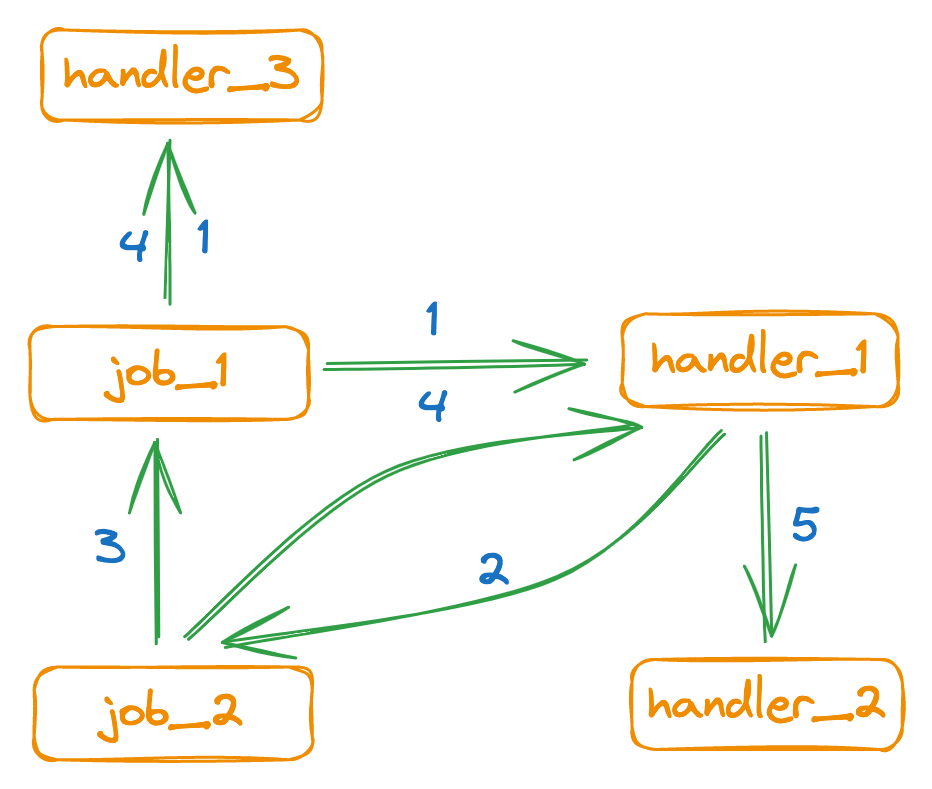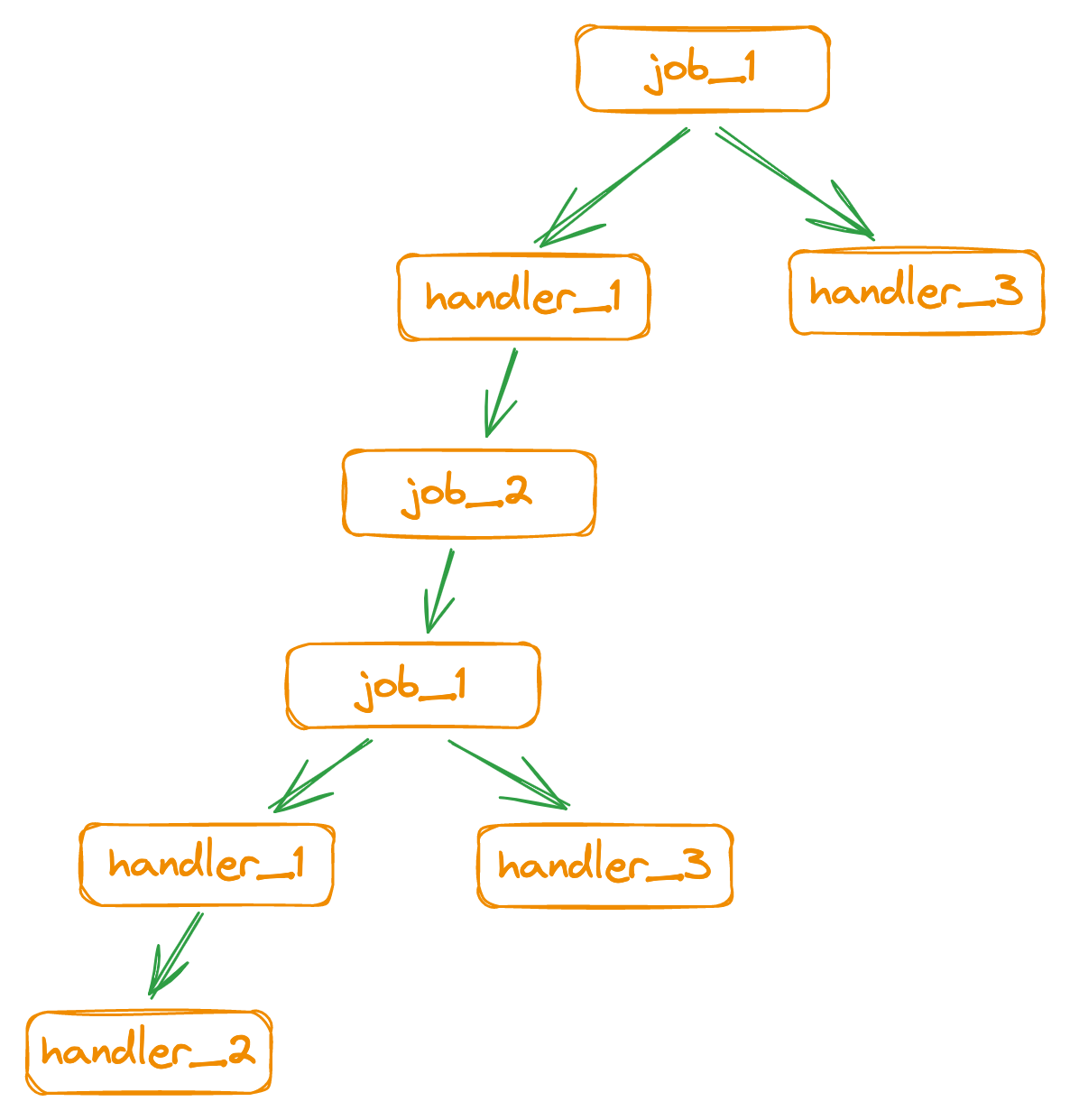Node-Edge Pattern
Agere is very flexible, and you can use the node+edge pattern to construct workflows. You can create various custom edge types through callbacks.
Defining an edge is simple, and here is an example code for add_edge:
from agere.commander._commander import Job, HandlerCoroutine
def add_edge(
from_node: Job | HandlerCoroutine,
to_node: Job | HandlerCoroutine,
data: Any | None = None,
) -> None:
"""To add a simple edge between two nodes.
The simple edge ensures that the next node is automatically executed after the previous node has completed.
Args:
from_node: The previous node.
to_node: The next node.
data: Shared data, which allows each node to access data from this object.
"""
async def next_node(from_node: Job | HandlerCoroutine, to_node: Job | HandlerCoroutine) -> None:
# This is important; it allows a completed node to be ready again so that it can run multiple times.
if to_node not in to_node.children:
to_node._children.append(to_node)
if isinstance(to_node, Job):
await from_node.put_job(to_node, parent=from_node.commander)
elif isinstance(to_node, HandlerCoroutine):
# This is important; it allows a handler object (coroutine object) to run multiple times.
to_node.reusable = True
from_node.call_handler(to_node, parent=from_node.commander)
else:
assert False, "The connected node should be a Job or handler object."
if isinstance(from_node, HandlerCoroutine):
from_node.reusable = True
if data is not None:
to_node.data = data
from_node.add_callback_functions(
which="at_job_end" if isinstance(from_node, Job) else "at_handler_end",
functions_info={
"function": next_node,
"params": {
"args": (from_node, to_node),
"kwargs": {},
},
},
)
Simple Edges and Conditional Edges
Currently, Agere offers two pre-set common edge types: add_edge and add_conditional_edge.
add_edge adds a simple edge between two nodes. After the preceding node completes execution,
the following node will automatically execute. Its function signature is
add_edge(from_node: Job | HandlerCoroutine, to_node: Job | HandlerCoroutine, data: Any | None = None).
from_node is the previous node, to_node is the next node, and data is optional. If specified,
it will bind to the node's data attribute and can be directly accessed within the node.
It serves as a context variable for passing information between nodes, allowing each node to store and
retrieve information from this object.
Note
data is only bound to the node directed by each edge; therefore, the initial node should manually
configure resources, like init_node.data=data.
add_conditional_edge adds a conditional edge between two nodes. After the preceding node completes its
execution, based on its return value, the conditional edge selects the appropriate next node to execute.
Its function signature is
add_conditional_edge(from_node: Job | HandlerCoroutine, map: dict[str, Job | HandlerCoroutine], data: Any | None = None).
from_node is the preceding node, and map is a dictionary storing the next nodes corresponding to
different outcomes of the preceding node. data is a resource object.
Note
data is only bound to the node directed by each edge; therefore, the initial node should manually
configure resources, like init_node.data=data.
Multiple Edges
You can add multiple edges to the same node, allowing them to execute simultaneously. For example, define the following nodes:
from agere.commander import (
CommanderAsync,
Job,
HandlerCoroutine,
handler,
tasker,
PASS_WORD,
)
from agere.commander.edge import add_edge, add_conditional_edge
@handler(PASS_WORD)
async def handler_1(self_handler):
self_handler.data["nodes"].append("handler_1")
self_handler.data["count"] += 1
return "handler_2" if self_handler.data["count"] > 4 else "job_2"
@handler(PASS_WORD)
async def handler_2(self_handler) -> None:
self_handler.data["nodes"].append("handler_2")
self_handler.data["count"] += 1
@handler(PASS_WORD)
async def handler_3(self_handler):
self_handler.data["nodes"].append("handler_3")
class Job1(Job):
@tasker(PASS_WORD)
async def task(self):
self.data["nodes"].append("job_1")
self.data["count"] += 1
class Job2(Job):
@tasker(PASS_WORD)
async def task(self):
self.data["nodes"].append("job_2")
self.data["count"] += 1
return "job_1" if self.data["count"] % 3 == 0 else "handler_1"
job_1 = Job1()
job_2 = Job2()
handler_1 = handler_1()
handler_2 = handler_2()
handler_3 = handler_3()
job_1.data = data # Set resources for the initial node
map = {
"job_1": job_1,
"job_2": job_2,
"handler_1": handler_1,
"handler_2": handler_2,
}
add_edge(from_node=job_1, to_node=handler_1, data=data)
add_edge(from_node=job_1, to_node=handler_3, data=data)
add_conditional_edge(from_node=handler_1, map=map, data=data)
add_conditional_edge(from_node=job_2, map=map, data=data)

